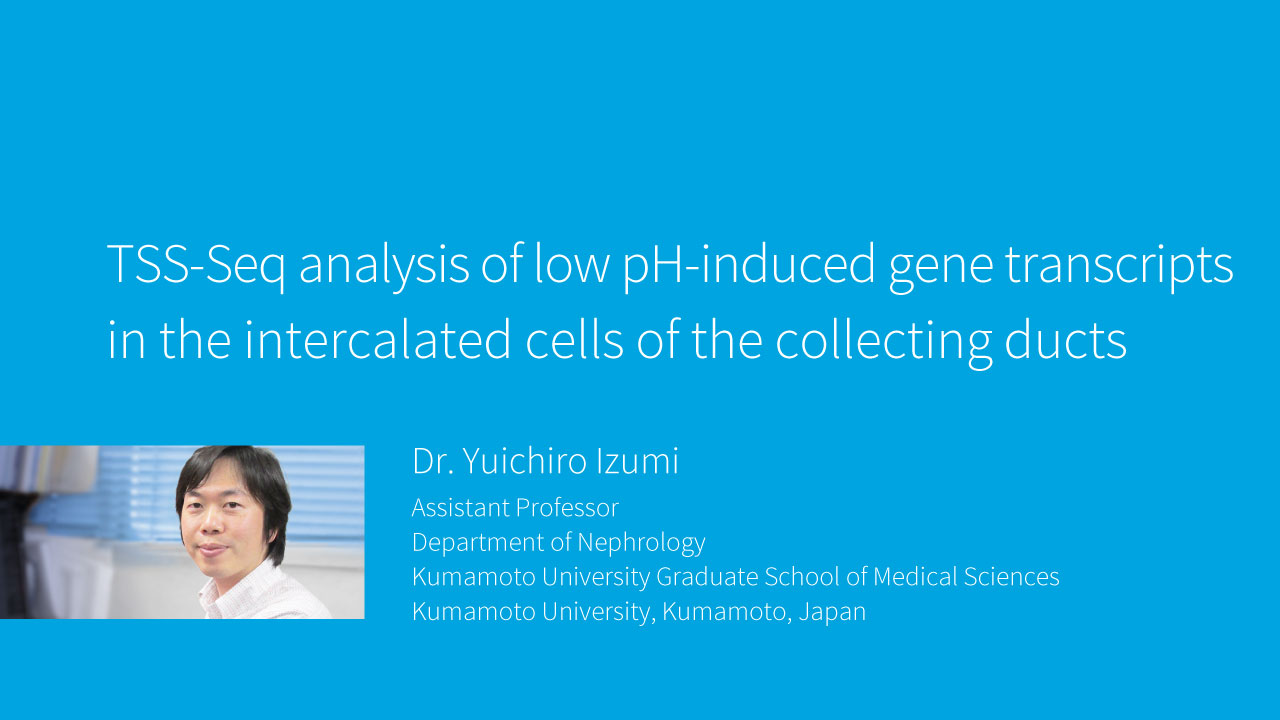Q&A
What is the focus of your research?
I am studying the mechanism of renal regulation of the acid-base balance. The acid we take in from food is excreted into the urine by the intercalated cells in the collecting duct in the kidney. Kidney disease occurs when acid excretion decreases, causing the accumulation of acid in the body, and eventually resulting in acidosis. Acidosis is known to aggravate kidney disease. The ultimate goal of my current project is to develop a novel therapy for kidney disease by regulating the mechanism of acid excretion. In this experiment, we used CAGE to investigate the effect of hormones, acid excretion, and acid load on the intercalated cells, using an intercalated cell line.
What inspired you to pursue this line of research?
I have been studying the physiological functions of renal tubules since I was a graduate student. I have studied the regulation of renal tubule functions caused by hormones and changes in osmotic pressure. However, the other potential factor, namely, the mechanism of acid excretion, has not been investigated in detail. Therefore, this has become my next focus.
Have you performed genome-wide expression analysis before?
Though it is not my original field of expertise, I was involved in a joint research project in my previous lab, in which we used comprehensive analysis. I have since gained more experience.
Microarray is probably the most traditional method; however, by nature, microarray is capable of profiling only predefined sets of some hundred genes. After we had just started deep sequencing in my previous lab, I learned about TSS sequencing. I was using a different method for TSS sequencing back then, but now I think that CAGE is more reliable. I choose CAGE now, because it allows us to comprehensively analyze more genes by a more reliable method at the transcriptional level.
What new discoveries did you make by using CAGE?
Some notable factors have started to emerge through ongoing analysis in collaboration with DNAFORM. We think that these results need to be reinforced with experiments using molecular biology techniques. Therefore, we are currently designing additional in vivo and in vitro experiments.
What expectations did you have for CAGE?
The advantages of CAGE among sequencing methods are that it allows identification of transcription start sites and provides a comprehensive picture of transcriptional activity. In the picture, I hope to find what my research is focused on, namely, stimulation-specific transcriptional activation and pathways to activate transcription. I chose CAGE in anticipation of such findings.
What are the key advantages of using CAGE?
My answer may not be directly pointing at the advantage of CAGE itself. My studies in the U.S. made me realize that sequencing alone is not complete; subsequent data analysis after sequencing is more important. Currently, however, Japan is short of skills and facilities capable of such analysis. DNAFORM specializes in the CAGE method, and at the same time, offers analytical services. An environment equipped with both facilities and capable people is the source of DNAFORM’s competence.
How did you learn about CAGE?
A friend from my previous institution who was engaged in sequencing told me about it as an option. Although I was using a totally different sequencing method, I searched it. CAGE is based on the traditional 5’ RACE technology, and I thought it would be reliable based on its simplicity.
Are there any aspects of CAGE that need improvement?
My greatest expectations concern current sequencing trends. I really hope and expect that CAGE will grow into a technology that enables analysis of smaller samples, even a single cell, if possible.
Would you recommend the CAGE library analysis service to your friends or colleagues? Please rate the usefulness of CAGE on a scale of 0 (would definitely not recommend it) to 10 (would definitely recommend it).
I, myself, would choose CAGE again. I give CAGE a “10” with my expectations for its technological future.
What do you hope to achieve with your research?
My research approach has been molecular biology and physiology. From my perspective, just looking at the molecular level is not interesting enough, because one cannot see the whole picture. I hope to advance my research with well-designed experiments combining comprehensive analysis with molecular biology.

